|
Vance Stevens starts the narrative.
Vance
Stevens, Higher Colleges of Technology/CERT/KBZAC, Al Ain, United Arab
Emirates
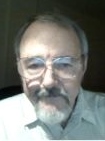 To start the story, English teaching has had a natural affinity
for the online environment, which grows with each new development in
Web 2.0 connectivity. The authors are, in order of appearance, as
follows. Vance Stevens is a founding member of the Computer-Assisted
Language Learning Interest Section (CALL-IS) who has been experimenting
with computer-mediated communications tools for the past 20 years in
teaching EFL online and connecting colleagues in professional
development. Next, we hear from Christine Bauer-Ramazani, who was
instrumental in starting both the Electronic Village (EV) Online in 2001
and CALL-IS webcasting in 2006. Then, Jack Watson takes over the story
with his succession as the CALL-IS webcast coordinator from Christine
and Chris Sauer. He is followed by the next coordinator, Abe Reshad, who
initiated a radical shift in our approach to webcasting through
skillful utilization of YouTube/Live. Abe passes the baton to Jennifer
Meyer, one of our most astute webcasting newbies, who explains how she
learned the ropes well enough to take on the role of CALL-IS webcast
coordinator from Abe forward to the TESOL 2018 convention in Chicago,
Illinois, USA next year. To start the story, English teaching has had a natural affinity
for the online environment, which grows with each new development in
Web 2.0 connectivity. The authors are, in order of appearance, as
follows. Vance Stevens is a founding member of the Computer-Assisted
Language Learning Interest Section (CALL-IS) who has been experimenting
with computer-mediated communications tools for the past 20 years in
teaching EFL online and connecting colleagues in professional
development. Next, we hear from Christine Bauer-Ramazani, who was
instrumental in starting both the Electronic Village (EV) Online in 2001
and CALL-IS webcasting in 2006. Then, Jack Watson takes over the story
with his succession as the CALL-IS webcast coordinator from Christine
and Chris Sauer. He is followed by the next coordinator, Abe Reshad, who
initiated a radical shift in our approach to webcasting through
skillful utilization of YouTube/Live. Abe passes the baton to Jennifer
Meyer, one of our most astute webcasting newbies, who explains how she
learned the ropes well enough to take on the role of CALL-IS webcast
coordinator from Abe forward to the TESOL 2018 convention in Chicago,
Illinois, USA next year.
The story starts with what was likely the first real webcast
from a TESOL convention, when CALL-IS went online from Salt Lake City,
Utah, USA on 10 April 2002. Pulled off successfully as a
proof-of-concept, the event, called "Theory Meets Practice in CALL" was
presented by Joy Egbert, Elizabeth Hanson-Smith, Deborah Healey, Vance
Stevens, Thomas Robb, and Lynn Hendrickson. Look for details here.
As the story continues, Christine Bauer-Ramazani organized the first official CALL-IS webcasts for TESOL 2006, where she and Chris Sauer functioned as moderators/interviewers. She takes up the story below.
Christine
Bauer-Ramazani, Saint Michael’s College, Colchester, Vermont,
USA
 The following year at TESOL 2007 in Seattle, Washington, USA
six presentations from the EV Fair Classics of the EV were webcast. The
six sessions followed the schedule of the EV Fair Classics, with each
presentation lasting 30 minutes, then repeated. Participants in the
audience consisted mainly of webheads as well as moderators and EV
Online participants, but word of these virtual sessions from the EV at
the annual TESOL conventions continued to spread, increasing audience
participation significantly each year. The following year at TESOL 2007 in Seattle, Washington, USA
six presentations from the EV Fair Classics of the EV were webcast. The
six sessions followed the schedule of the EV Fair Classics, with each
presentation lasting 30 minutes, then repeated. Participants in the
audience consisted mainly of webheads as well as moderators and EV
Online participants, but word of these virtual sessions from the EV at
the annual TESOL conventions continued to spread, increasing audience
participation significantly each year.
Table 1: Links to webcasts through the years (2006-2017)
See Appendix 1 for full links to these webcast portals.
For the 2010 webcasts, the webcasters began using Elluminate,
now Blackboard Collaborate, a web-conferencing platform with
audio/video. Vance Stevens had arranged access to the “Webheads Virtual
Office” Blackboard Collaborate/Elluminate room for use by the CALL-IS,
courtesy of a grant from LearningTimes. The
LearningTimes Elluminate room was the tool of choice for CALL-IS
webcasting until Jack Watson used another instantiation of it in 2015,
made available through his college. Now Jack adds his part.
Jack
Watson, University of New Brunswick, Fredericton, New
Brunswick, Canada
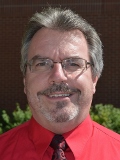 Boston, Massachusetts, USA, 2010: The way I
remember it, I’m seated directly behind Christine Bauer-Ramazani,
peering unobtrusively (I think) over her shoulder as she webcasts a
session. Webcast audio is delivered directly through the speakers, and
the Wi-Fi delivers the message clearly and globally. Presenters speak
and shift their PowerPoint slides, and Christine advances the
corresponding slides online in the Elluminate program, all the while
engaging the online audience through questions and commentary in the
chat function. And it works. To me, the event was at once fascinating,
challenging, and rife with potential for international access and
participation. Twice more I watched webcasters (Chris Sauer and Carla
Arena) whose expertise belied the complexity of preparation and
execution. I definitely wanted, and didn’t want, to do this. Boston, Massachusetts, USA, 2010: The way I
remember it, I’m seated directly behind Christine Bauer-Ramazani,
peering unobtrusively (I think) over her shoulder as she webcasts a
session. Webcast audio is delivered directly through the speakers, and
the Wi-Fi delivers the message clearly and globally. Presenters speak
and shift their PowerPoint slides, and Christine advances the
corresponding slides online in the Elluminate program, all the while
engaging the online audience through questions and commentary in the
chat function. And it works. To me, the event was at once fascinating,
challenging, and rife with potential for international access and
participation. Twice more I watched webcasters (Chris Sauer and Carla
Arena) whose expertise belied the complexity of preparation and
execution. I definitely wanted, and didn’t want, to do this.
New Orleans, Louisiana, USA, 2011: We had
four sessions webcast. The success of more experienced webcasters was
not to be my fate. Ambient noise, speaker feedback, the error of having
two Elluminate moderator rooms with active mics, and my own inexperience
rendered some sessions unrecordable.
Philadelphia, Pennsylvania, USA, 2012: Audio
was vastly improved here, but by this time everyone in the convention
center had discovered Wi-Fi, causing intermittent connection at best.
Another lesson involved the importance of not trying to webcast
progressive slides—these transmit only part of the slide, with most
unfortunate results. So it was that only static slides would be
collected for webcasts.
Dallas, Texas, USA, 2013: By Dallas, I was
finally getting the hang of Elluminate. Gone were the progressive
slides, audio was markedly clearer at all times, and there was a
dedicated DSL for the webcast machine. In 2013, webcast audience members
hailed from 24 different countries. With eight sessions webcast, the
need for more webcast volunteers and at least two platforms was becoming
clear.
Portland, Oregon, USA, 2014: The 2014
iteration of CALL-IS EV and Technology Showcase saw 15 sessions
successfully webcast. Up to this point, the webcast team had used a
system of paired teams consisting of a lead and an assist. For Toronto,
we added a third: volunteer observer, who could watch the webcast team
in action, collect a
record of online participants’ countries of origin, and find
in-house technical help when needed. The University of New Brunswick in
Fredericton, Canada, lent its Blackboard Collaborate system for use in
the EV Fair Classics from Portland.
Toronto, Ontario, Canada, 2015: Abe Reshad
began training to take up the mantle of webcast coordinator, and we
webcast 11 sessions. Because we now had cultivated a solid core of
webcast volunteers, the challenge for the following year would be to
webcast every session we could.
Baltimore, Maryland, USA, 2016: With Abe
down with a flu, I served as on-site webcasting anchor. Thanks to the
growing team of volunteer webcasters (16 in total) and Abe’s planning,
the challenge of fulfilling duties of CALL-IS chair and webcast anchor
could be met. Abe took the helm of an ad hoc committee to investigate,
develop, and institute that new approach. Next, Abe relates his
experience.
Abraham
Reshad, Ohio University, Athens, Ohio, USA
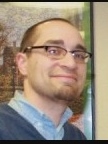 Reflecting on the years of webcasting in the CALL-IS, it seems
clear that in the year 2016 there was a critical mass. TESOL 2016 marked
a record number of webcast sessions since the CALL-IS began offering
webcasts as a service to educators, and this milestone brought with it
the need to find a sustainable and customizable product that could meet
the growing diversity in both the content being delivered and the web
audience being served. The CALL-IS steering committee allocated
resources for the aforementioned ad hoc committee. The criteria for the
platform were for it to be free, customizable for our purposes, simple
(in terms of content delivery), and interactive (with some form of
audience/webcaster interaction allowed). Google came to the rescue with
its free and robust live streaming services through YouTube Live
(Stevens, 2017, explains the process). Reflecting on the years of webcasting in the CALL-IS, it seems
clear that in the year 2016 there was a critical mass. TESOL 2016 marked
a record number of webcast sessions since the CALL-IS began offering
webcasts as a service to educators, and this milestone brought with it
the need to find a sustainable and customizable product that could meet
the growing diversity in both the content being delivered and the web
audience being served. The CALL-IS steering committee allocated
resources for the aforementioned ad hoc committee. The criteria for the
platform were for it to be free, customizable for our purposes, simple
(in terms of content delivery), and interactive (with some form of
audience/webcaster interaction allowed). Google came to the rescue with
its free and robust live streaming services through YouTube Live
(Stevens, 2017, explains the process).
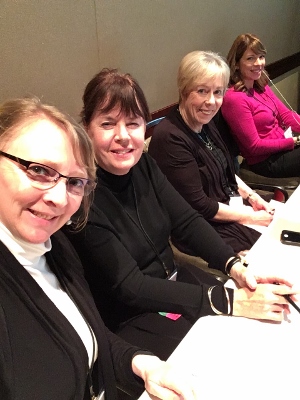
Webcasting in Seattle 2017. (From left: Jennifer Meyer, Ellen
Dougherty, Christine Bauer-Ramazani, Heather Benucci)
TESOL 2017 quickly came and, despite the hours put into
planning for the conference and preparing the team (with instructional
videos and live meetings), we immediately encountered a good number of
curve balls when we started setting up and testing equipment in Seattle.
Not knowing the dimensions of conference rooms and location of outlets
makes webcasting prep quite challenging. Fortunately, I have the
pleasure of working with individuals who love a challenge. We eventually
came up with a decent setup before the first presentation.
Finally, Jennifer Meyer takes over the narrative.
Jennifer Meyer,
Williamson County Schools, Franklin, Tennessee, USA
 In January 2016, I joined the webcasting team through a generic
call for volunteers put out by TESOL. My name was forwarded to Abe, the
Webcasting Team leader, and he contacted me about joining the group. I
really had no idea what I was getting myself into, but it sounded
interesting, and I was up for learning something new. Shortly after
that, I was invited to an online training session using the Blackboard
Collaborate software. Initially, I thought I’d never be able to figure
out how to even log in to the meeting, but it was actually very simple. Veteran webcasters were all very helpful and made
me feel like my questions were being asked for the first time, even
though I’m pretty sure they had heard them several times over the years. In January 2016, I joined the webcasting team through a generic
call for volunteers put out by TESOL. My name was forwarded to Abe, the
Webcasting Team leader, and he contacted me about joining the group. I
really had no idea what I was getting myself into, but it sounded
interesting, and I was up for learning something new. Shortly after
that, I was invited to an online training session using the Blackboard
Collaborate software. Initially, I thought I’d never be able to figure
out how to even log in to the meeting, but it was actually very simple. Veteran webcasters were all very helpful and made
me feel like my questions were being asked for the first time, even
though I’m pretty sure they had heard them several times over the years.
After our successful webcasting in Baltimore, the team
discussed some of the limitations and problems with hardware and
software. As Abe mentioned previously, he put together a committee to
explore other options for webcasting for Seattle 2017. James May,
Heather Benucci, Abe, and I started researching different solutions and
met several times to hash out details. We settled on Open Broadcaster
Software (OBS) to encode videos to webcast using YouTube Live. Some
reasons we chose this configuration were ease of use, universal
accessibility, and, best of all—price. It is free of charge: free to
stream, free to record, free to archive, free to publish information
about, and free to watch.
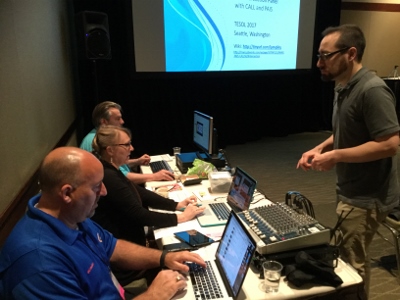
Seated front to back: James May, Jennifer Meyer, Jack Watson, Abe Reshad (standing)
At the end of the conference in Seattle, Abe stepped down as
team leader and I took on the responsibility. We held an online meeting a
month after the conference to reflect on our experience and to plan for
optimization for next year’s conference in Chicago. Major points from
this discussion included budgeting for hardware to webcast most
efficiently and professionally. We also discussed the organization of
sessions and reorganizing these to more easily facilitate the different
hardware configurations needed to live stream. Finally, we discussed
branding our webcasting with graphic design to use on our YouTube
channels and as a part of the live streams that we webcast. As always,
it is the contributions of the entire team that make us so successful
and make the collaboration enriching and enjoyable.
Note: This article has previously been published and
is available in a much longer format: Bauer-Ramazani, Meyer, Reshad,
Stevens, & Watson, 2017.
References
Bauer-Ramazani, C., Meyer, J., Reshad, Al, Stevens, V.,
& Watson, J. (2017). A brief history of CALL-IS webcasting in
the new millennium. TESL-EJ, 21(1), 1–16. Retrieved
from http://tesl-ej.org/pdf/ej81/int.pdf
Stevens, V. (2017).
Configure encoders, stream YouTube Live, and record lesson materials
on-the-fly: A manual-in-progress. Retrieved from https://docs.google.com/presentation/d/12KL1390JLzBsopdsMLMi6ZHNC23CEzT2biNp0mCOV3M/edit?usp=sharing
Jennifer Meyer is an elementary ESL Specialist at a public
school in Brentwood, Tennessee, and a PhD student in Literacy Studies at
Middle Tennessee State University.
Jack Watson is the ELP E-Learning Coordinator at the University
of New Brunswick English Language Programme. Now CALL-IS Past Chair, he
has delivered several webcasts from Technology Showcase and Electronic
Village Fair Classics, and served for four years on the TESOL CALL-IS
Web Cast Development Team, including two years as Coordinator. During
his tenure, the number of mentored webcast volunteers increased from
four to fifteen, and the number of webcast sessions increased from four
to fourteen.
Christine Bauer-Ramazani (MBA, MA, MEd) is a 40-year veteran
instructor of English and teacher trainer, former CALL-IS chair, author
of articles and chapters, frequent presenter at conferences around the
world, designer and teacher of several online/distance courses, and
co-founder of the Electronic Village Online (EVO) of
TESOL.
Abraham Reshad serves as a Lecturer and database/CALL
coordinator in the Ohio Program of Intensive English (OPIE) at Ohio
University. For three years, he has utilized mobile media to augment
classroom instruction in terms of reading and vocabulary. Now, he
focuses on augmented reality mobile applications and Ohio University's
Holodeck.
Vance Stevens teachers EFL at the air college in Al Ain, UAE.
He is founder of Webheads in Action, edits On the Internet
for TESL-EJ, hosts a podcast series Learning2gether with over 360 episodes, and
serves TESOL CALL-IS Electronic Village Online as coordinator, plus
founder / co-moderator of EVO Minecraft MOOC. |

